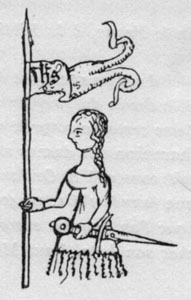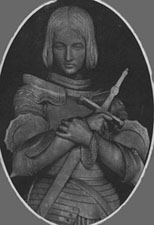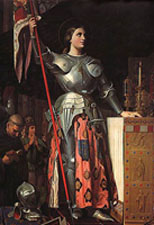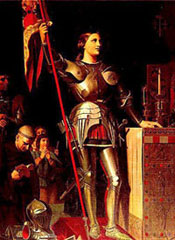What is the historical significance of Joan of Arc?


During her life, Joan of Arc was instrumental in reviving the dead and near extinct code of chivalry by first trying to presidia the English to leave France peacefully and then by insisting that the captured enemy be treated with mercy and not like some sort of property to be disposed of as the captor wished. She was the catalyst that ended the Hundred Years War by insisting that the French army fight to win and not just 'play' at war and in so doing she helped to end the suffering of the common people and bring peace to the war ravaged kingdom.
Ever since her death Joan of Arc has inspired both men and women to great deeds of valor. Women from Greece, Turkey and China were inspired by her story to fight for their countries' freedom. Even Florence Nightingale was inspired by Joan to help nurse the wounded soldiers on the battlefield. She greatly influenced the lives of Annie Oakely and Mark Twain. Joan influenced Churchill and General Charles De Gaulle as well as inspiring the Free French Resistance to Nazi Occupation during World War Two.
Down through the centuries she has inspired both artists and authors alike. After Jesus Christ and Napoleon, Joan of Arc is the third most popular subject in western culture. We know from Joan's own testimony that she saw a painting of herself presenting the Dauphin with a letter. After the Coronation of Charles medals were struck to commemorate her victories but the likeness was poor.
We do not have one authenticated picture of what Joan of Arc actually looked like. The pictures that have come down to us all seem to resemble different aspects or views of the actual Joan. A crude caricature of Joan was done by a Burgundian who never even saw her.
Ten years after her death she was compared to the Old Testament heroine, Judith. Crudely made miniatures (pictures) were made to illustrate King Charles' triumph over the English. In these she was always shown in long flowing dresses with long uncut hair, completely ignoring the fact that Joan of Arc dressed, lived, and fought as a man. This is a subject that has always been a stumbling block to apologetic authors who had no real grasp for Joan's necessity and insistence upon dressing like a man. Let her career speak for itself.



The picture on the left was done in 1854 by Dominique Ingres which depicts Joan of Arc at the Coronation in full armor with a long flowing skirt. This picture is the most popular. The other image was done by Ingres' student a year later. (The right hand picture is used with permission the Museum of Fine Arts, Orleans, France.)
In literature she has inspired countless books, plays, songs and poems. Mark Twain's The Personal Recollections of Joan of Arc, Bernard Shaw's Saint Joan, Boutet de Monvel's Joan of Arc, Vita Sackville-West's Saint Joan of Arc just to name a few.
Regine Pernoud's prolific works on this subject are the most refined and scholarly sources available. I cite her as my best source and highly recommend her work entitled Joan of Arc By Herself and Her Witnesses published by Sarcborough House of Lanham, Maryland, which is still in print, for those who are searching for the TRUE Joan of Arc. I have personally met this charming and gracious lady on one of my research tours of France.
4) What is the significance of her being a saint?
It is the ultimate reparation of the Catholic Church to someone whom it unjustly condemned to death.
Of course the Church did not canonize her for this reason. After five hundred years the Catholic Church officially recognized Joan's heroic virtues, the same virtues that are found in all the saints of God. She was possessed with LOVE of GOD. Her undying spirit continually inspires souls to reach for this holiness, this closer union with the Triune God.
Saints transcend the human condition by going beyond themselves to serve God through serving their fellow human beings. They strive for an unknown destination which can sometimes cost them their lives as it did in Joan's case. Joan's complete openness and willingness to pay this price is her everlasting crown of glory, her greatest victory.
5)Why is Joan of Arc important to you personally?
My love for Saint Joan has grown and developed over the years. When I was a child, I loved her for her strength, her courage, her power, her ability to lead armies and command men. As I grew older and I learned more about her, I grew to love her ability to endure adversity patiently, her steadfastness and loyalty to a king who had abandoned her to her enemies. But most of all I learned to admire her love, loyalty and patient acceptance of God's Will for her life. I strive for this with all my heart. I love her because she loves me just the way I am with all my weakness and failings. She is my dearest and closest friend. She has never failed me and is always with me helping me to live my life as God would have me live it.
 Index
Index
 Previous Question
Previous Question
 Next Question
Next Question